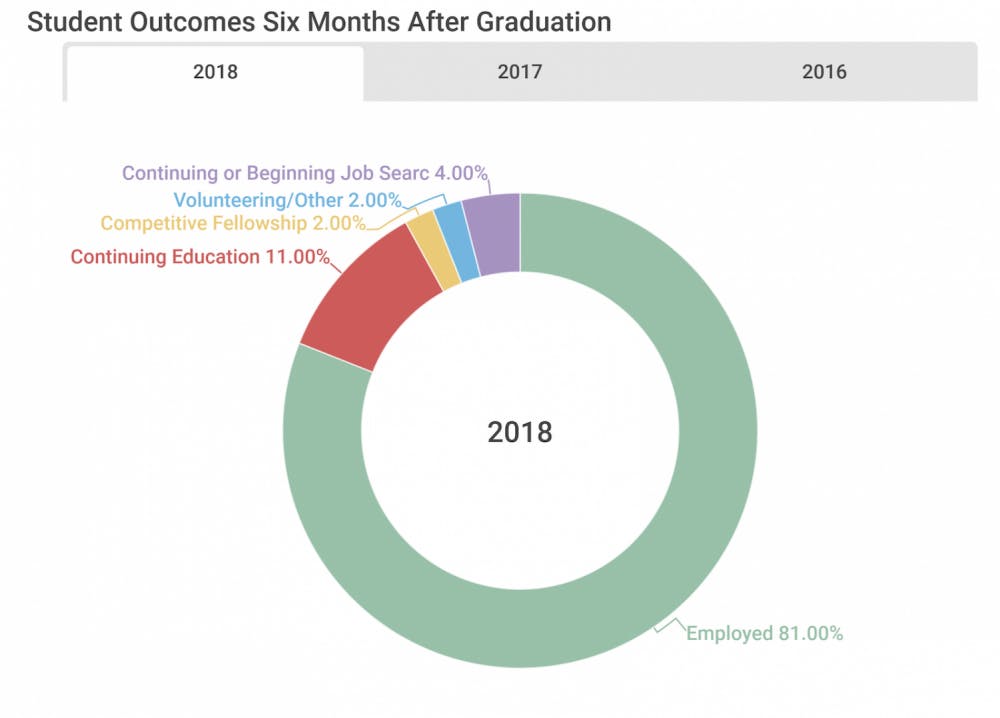 The percentage of Middlebury graduates with jobs within months of their graduation date has been steadily rising since 2014.
The percentage of Middlebury graduates with jobs within months of their graduation date has been steadily rising since 2014.
Six months after graduation, 81% of the class of 2018 had found employment, the highest rate on record. Most of these graduates are working full-time jobs while others, also included in this definition of employment, are working part-time while studying or pursuing an additional career.
As of Aug. 1, two months after graduation, 69% of the class of 2019 was employed, representing a 50% increase from the class of 2014, according to Peggy Burns, director of the Center for Careers and Internships (CCI).
 Even considering rising national employment rates, Burns said that the CCI’s increasing efforts over the last five years to help students find employment has also contributed markedly to this growth. Most notably, the center has increasingly funneled alumni enthusiasm through several new programs that help emerging grads enter the workforce.
Even considering rising national employment rates, Burns said that the CCI’s increasing efforts over the last five years to help students find employment has also contributed markedly to this growth. Most notably, the center has increasingly funneled alumni enthusiasm through several new programs that help emerging grads enter the workforce.
These efforts include the creation of seven Middlebury Professional Networks (MPNs), consisting of alumni who volunteer to provide active career support in the fields of consulting, energy and environment, financial services, government and policy, international affairs, media and entertainment, and technology. The center aims to expand these offerings in the future, according to its website.
The CCI also created a program called “Student Treks” in 2017, which brings students on themed trips where they learn about a career pathway through meeting alumni, visiting their worksites, and shadowing them on the job.
 Eight times a year, the center’s Field Guide program brings five or six alumni, who all shared the same major but have gone on to diverse careers, to speak with students. The CCI also brings alumni who work in the same industry, regardless of their major, through a program called Up Next.
Eight times a year, the center’s Field Guide program brings five or six alumni, who all shared the same major but have gone on to diverse careers, to speak with students. The CCI also brings alumni who work in the same industry, regardless of their major, through a program called Up Next.
“[The alumni] have always stepped up when asked. Now all these vehicles are set up where they can really channel their energy and enthusiasm for our students,” Burns said. In the last academic year, 500 alumni engaged in on and off-campus programming.
This year, the CCI created Midd2Midd, an online platform that connects members from across the Middlebury community. The platform hosts three programs: MiddMentors, which connects students with alumni mentors; MiddConnect, which allows students, alumni, and parents to ask for advice and share opportunities amongst each other; and MiddGroups, which hosts affinity-based communities of alumni and students.
The CCI also switched its online job-posting platform from Mojo to Handshake, both of which are sites used by colleges and universities across the country to aggregate job and internship opportunities. The switch is part of an effort to diversify the types of work Middlebury graduates pursue
Handshake makes it much easier for employers to post opportunities than Mojo, vastly increasing both the number and types of opportunities available to students, according to Burns. In the last academic year, employers posted 22,000 jobs and internships on Handshake, 10 times as many as with Mojo, on average. Middlebury students responded with 12,000 applications submitted through the site.

 Recent shifts in industries that graduates are choosing to pursue reflect students’ ever-evolving interests. For the first time in years, the fields of arts and communication constitute the foremost employer for the class of 2018, according to a survey by the Office of Assessment & Institutional Research (OAIR) conducted six months after their graduation. Financial services, usually the most popular field, came in second, followed by education, consulting, technology, and science and health, amongst others. Social justice forms the smallest employment sector accounting for just 5% of those employed. However, Burns cautioned that these rankings do not tell the full story, as many jobs overlap categories.
Recent shifts in industries that graduates are choosing to pursue reflect students’ ever-evolving interests. For the first time in years, the fields of arts and communication constitute the foremost employer for the class of 2018, according to a survey by the Office of Assessment & Institutional Research (OAIR) conducted six months after their graduation. Financial services, usually the most popular field, came in second, followed by education, consulting, technology, and science and health, amongst others. Social justice forms the smallest employment sector accounting for just 5% of those employed. However, Burns cautioned that these rankings do not tell the full story, as many jobs overlap categories.
While only 11% of the class of 2018 immediately pursued postgraduate education after graduation, 50% reported that they intend to do so within the next five years, according to the OAIR survey. Out of the NESCAC schools, Burns said Middlebury is on the lower end of the spectrum in terms of how many students transition straight to graduate school. While both Amherst and Hamilton also reported that 11% of the class of 2018 immediately entered postgraduate school, 15% of Bowdoin students, 19% of Tufts students, and 20% of Connecticut College students continued their education directly after completing undergrad. Burns said she sees this difference as a strength rather than a weakness.
“Graduate schools feel that students get more out of grad school, and grad school get more out of students when students have been out in the world and are more mature,” she said.
The center also aims to increase levels of participation by younger students in its activities and counseling. Burns encouraged students to come to the CCI early and often to prepare themselves and reduce stress come graduation. The center offers drop-in hours with peer career advisors every afternoon, and students can sign up for longer meeting with staff on Handshake.

Sophia McDermott-Hughes ’23.5 (they/them) is an editor at large.
They previously served as a news editor and senior news writer.
McDermott-Hughes is a joint Arabic and anthropology and Arabic major.
Over the summer, they worked as a general assignment reporter at Morocco World News, the main English-language paper in Morocco.
In the summer of 2021 they reported for statewide digital newspaper VTDigger, focusing on issues relating to migrant workers and immigration.
In 2018 and 2019, McDermott-Hughes worked as a reporter on the Since Parkland Project, a partnership with the Trace and the Miami Herald, which chronicled the lives of the more than 1,200 children killed by gun violence in the United States in the year since the Marjory Stoneman Douglas High School shooting in Florida.




